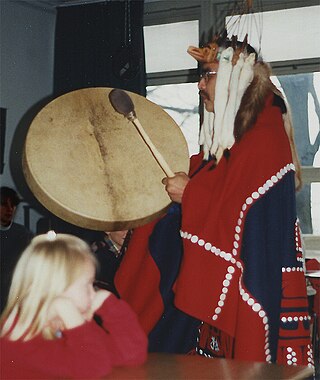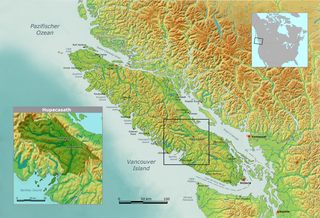History
Potlatch, which means "to give" or "a gift" in the Chinook Jargon, [5] became adapted to refer to "the different ceremonies among [the] many nations of the Pacific Northwest that ... [include] feasting, dancing and giving gifts to all in attendance". [6] It is also described somewhat more completely by The Story of the Masks website from the U'mista Cultural Centre in Alert Bay as "The potlatch refers to the ceremony where families gather and names are given, births are announced, marriages are conducted, and where families mourn the loss of a loved one. The potlatch is also the ceremony where a chief will pass on his rights and privileges to his eldest son." [5]
The British Columbia Indian Office, specifically the Indian Commissioner, I. W. Powell, had found the native peoples to be rich and hardy, but also found they appeared as if they were poor. [7] This finding led to further research on the subject of potlatches where it was found that to the Indigenous peoples of the region, the Potlatch was a great institution. It encouraged people to give away their earnings and possessions (including slaves). In exchange, the giver would receive a great deal of respect and be seen as honourable to his tribe and others. [8]
However, Canadian Prime Minister John A. Macdonald did not see this tradition as valuable or appropriate and, under the guise of unifying the Dominion of Canada, encouraged the government to lay "an iron hand on the shoulders of the [native] people" by restricting some of their non-essential, inappropriate rituals and leading them towards what he perceived as a "healthier" European mindset. [9] Work thus began on an amendment to the Indian Act of 1880. Some criticized the idea, such as James Benjamin McCullagh in his essay on the tribal lifestyle of the indigenous peoples of Canada, "The Indian Potlatch". [10]
In the third section of the Indian Act, signed on April 19, 1884, it was declared that:
Every Indian or other person who engages in or assists in celebrating the Indian festival known as the "Potlatch" or in the Indian dance known as the "Tamanawas" is guilty of a misdemeanor, and liable to imprisonment for a term of not more than six nor less than two months in any gaol or other place of confinement; and every Indian or persons who encourages ... an Indian to get up such a festival ... shall be liable to the same punishment. [11]
.
Sectors of native communities themselves also wanted to ban the Potlach. In 1883 the department of Indian affairs received a petition from the Coast Tsimshian and Nisga’a Chiefs at Port Simpson, Kincolith, Green Ville "praying that the system of Potlatching as practiced by many Indian Tribes on the Coast of British Columbia may be put down” [12]
There were others who wanted to keep the practice of Potlach alive. German-born anthropologist Franz Boas not only opposed the ban; with the help of his First Nations assistant, he actually hosted one. Despite various opinions on the matter, the ban was eventually enacted, lasting until repealed in 1951. Some first Nations opponents of the ban saw the law as an instrument of injustice and intolerance. [13]
Reasons for the ban
As Canada expanded, they adhered to a number of ideologies at the time, including converting their colonial subjects to Christianity. Seeing that the potlatch was at the heart of a non-Christian cultural system that opposed colonization, the potlatch was targeted by missionaries and colonial officials.
Though there was an obvious political motivation for suppressing the potlatch, it was also very foreign to the norms of Protestant and mercantile Euro-Canadians who found it hard to comprehend. They saw the ritualistic act of giving away nearly all of one's hard-earned possessions as a sign that the indigenous people were "unstable". Under the encouragement of the Indian Reserve Allotment Commission, the Indian Reserve Commission, and the Anglican Church, this behaviour was deemed as a possible destabilizing force in the nation because it was so dramatically opposed to the values of the ideal "Christian capitalist society". [1]
Two major players in the Canadian potlatch ban were George Blenkinsop and Gilbert M. Sproat. Blenkinsop was a government agent commissioned to survey the lifestyle of the indigenous peoples residing in Barkley Sound. His findings on native culture were not encouraging to the Government, as he reported that there was "little hope of elevating ... [the natives] from their present state of degradation" without eliminating ceremonies such as the potlatch. [9] Gilbert M. Sproat, on the other hand, was a "joint Federal-Provincial appointee to the Indian Reserve Commission". [9] In this regard, he had worked closely with different native groups and tribes throughout British Columbia. In 1879, Sproat sent a strongly worded letter to Prime Minister John A. Macdonald. [9] In the letter, Sproat declared that the potlatch ceremony was "the parent of numerous vices which eat out the heart of the [native] people", and reaffirmed the words of Blenkinsop by assuring the Prime Minister that "It is not possible that the Indians can acquire property, or can become industrious with any good result, while under the influence of ... [the potlatch]". [9]
Sproat's opinion was a commonly held one for white employers in British Columbia. Euro-Canadians saw the potlatch as a pointless ceremony that did little but advance barbarity and retract the ability of the native peoples to fully assimilate themselves in mainstream society. [14] Essentially, the potlatch was an important ritual to the natives that prevented assimilation into the melting pot the Euro-Canadian government sought to enforce. [14]
Employers found similar problems. Many of the aboriginal peoples of 1800s British Columbia were often motivated to work in order to gain wealth which would permit them to buy more items for potlatches, which would result in greater honour. This work was often seasonal in nature. This was in direct contrast to the agendas of many of the "white" employers who ultimately were frustrated by what they perceived to be the native "work ethic". [1] According to John Lutz, written accounts of white employers were almost bipolar because of the indigenous peoples' seasonal working habits. This seasonal work permitted them to choose when they would work or when they would stay in their villages. Some employers deemed them "as 'indispensable' while [others] condemned their "unreliability" and "laziness". [1]
Missionaries of the northwestern regions of Canada also sent their opinions to the government. Most commonly they stated their arguments based on three fields: health, morality and economics. [15] On the issue of health, the missionaries worried about the spread of disease amongst the large groups that gathered for potlatches, and critiqued the native peoples' recklessness. [15] Specifically, they called out against the treatment of children, accusing those who attend potlatches of being responsible for the statistic claiming that "Six out of every ten [native] infants die" and that losing all of a family's possessions led to greater health risks to the family who hosted the potlatch. [16] On the issue of morality, missionaries claimed that potlatches and financial requirements led wives and "maiden daughters" of those hosting to turn to prostitution to help their fathers gather wealth, as well as the consumption of alcohol. [16] The issue of economics was simple in the notion that the native desire to give away all their goods was the opposite of the "Christian capitalist" values held in high esteem by Euro-Canadians. [1]
Results and legacy
The first person to be charged under the law was a Sto:lo man from Chilliwack, Bill Uslick, who horrified Indian agent Frank Delvin by giving away all his goods, "practically left himself destitute." [17] [18] He was arrested February 1, 1896, and sentenced to two months prison. [18] Upon its release, the amendment to the Indian Act was found to be ineffectual due to a lack of enforcement. [1] There are several recorded arrests in which the native peoples found loopholes in the edict and held potlatches in celebratory seasons, claiming to be doing what was "customary with white people during this season", and celebrating potlatches around holidays such as Christmas. [19] Other groups made formal requests that they be able to host potlatches, but were refused.
"The legal suppression of the potlatch became a symbol, in both native and white communities, of the Canadian treatment of British Columbia Indians." [2]
The potlatch ban was never entirely effective, though it did significant cultural damage, and continued underground through the period of the ban in a number of places and ways. The potlatch ban and related banning of the sun dance and Coast Salish dancing occurred during the height of repressive colonial laws in Canada, lasting until 1951. After 1951, the Indian Act was amended, removing some of the more repressive measures, including the ban on the potlatch.
After the ban was lifted, Nations on the coast began to openly potlatch again. The revival of open ceremony gained strength during the 1970s and 1980s, and it is once again widespread among many of the Nations that previously potlatched prior to the ban.

The Haida are an Indigenous group who have traditionally occupied Haida Gwaii, an archipelago just off the coast of British Columbia, Canada, for at least 12,500 years.

A potlatch is a gift-giving feast practiced by Indigenous peoples of the Pacific Northwest Coast of Canada and the United States, among whom it is traditionally the primary governmental institution, legislative body, and economic system. This includes the Heiltsuk, Haida, Nuxalk, Tlingit, Makah, Tsimshian, Nuu-chah-nulth, Kwakwaka'wakw, and Coast Salish cultures. Potlatches are also a common feature of the peoples of the Interior and of the Subarctic adjoining the Northwest Coast, although mostly without the elaborate ritual and gift-giving economy of the coastal peoples.

The Kwakwa̱ka̱ʼwakw, also known as the Kwakiutl, are one of the indigenous peoples of the Pacific Northwest Coast. Their current population, according to a 2016 census, is 3,665. Most live in their traditional territory on northern Vancouver Island, nearby smaller islands including the Discovery Islands, and the adjacent British Columbia mainland. Some also live outside their homelands in urban areas such as Victoria and Vancouver. They are politically organized into 13 band governments.
The Indian Act is a Canadian Act of Parliament that concerns registered Indians, their bands, and the system of Indian reserves. First passed in 1876 and still in force with amendments, it is the primary document that defines how the Government of Canada interacts with the 614 First Nation bands in Canada and their members. Throughout its long history, the act has been a subject of controversy and has been interpreted in different ways by both Indigenous Canadians and non-Indigenous Canadians. The legislation has been amended many times, including "over five major changes" made in 2002.

The Tsimshian are an Indigenous people of the Pacific Northwest Coast of North America. Their communities are mostly in coastal British Columbia in Terrace and Prince Rupert, and Metlakatla, Alaska on Annette Island, the only reservation in Alaska.

Haisla people are a First Nation who reside in Kitamaat. The Haisla consist of two bands: the Kitamaat people, residing in upper Douglas Channel and Devastation Channel, and the Kitlope People, inhabiting upper Princess Royal Channel and Gardner Canal in British Columbia, Canada.

The Heiltsuk, sometimes historically referred to as Bella Bella, or Híɫzaqv are an Indigenous people of the Central Coast region in British Columbia, centred on the island community of Bella Bella. The government of the Heiltsuk people is the Heiltsuk Nation, though the term is also used to describe the community. Its largest community is Bella Bella.

The Hupacasath First Nation is a First Nations government based in the Alberni Valley on the west coast of Vancouver Island in British Columbia, Canada. It is a member of the Nuu-chah-nulth Tribal Council. An alternate spelling of Hupacasath is Opetchesaht or Opitchesaht. Hupacasath First Nation consists of approximately 300 members across five reserves.

Douglas Lowell Cole was an American-Canadian historian. Cole specialized in the art and culture of the Northwest Pacific Coast, and from 1966 until 1997 served as a professor in the history department at Simon Fraser University.

The Coast Salish are a group of ethnically and linguistically related Indigenous peoples of the Pacific Northwest Coast, living in the Canadian province of British Columbia and the U.S. states of Washington and Oregon. They speak one of the Coast Salish languages. The Nuxalk nation are usually included in the group, although their language is more closely related to Interior Salish languages.

The Indigenous peoples of the Pacific Northwest Coast are composed of many nations and tribal affiliations, each with distinctive cultural and political identities. They share certain beliefs, traditions and practices, such as the centrality of salmon as a resource and spiritual symbol, and many cultivation and subsistence practices. The term Northwest Coast or North West Coast is used in anthropology to refer to the groups of Indigenous people residing along the coast of what is now called British Columbia, Washington State, parts of Alaska, Oregon, and Northern California. The term Pacific Northwest is largely used in the American context.
Alec Thomas was born around 1894 near Alberni, British Columbia, Canada. He was a fisherman, trapper, longshoreman, interpreter, self-taught anthropologist, and Tseshaht politician. Alec had a wife named Eva and also had a son named Bob. With him being a trapper he would lay traps for 14 miles between 2 bodies of water, the Somass River and Sprout Lake. At the end of the day, he would check each one with his wife and son, walking through his miles of traps. This is what he did for a living, hunting different animals such as fish and beavers.

Opitsaht, spelled also as Opitsat and Opitsitah, is a First Nations settlement/community in the Southwest area of the Meares Islands, Clayoquot South, British Columbia. This peninsula-like region is the home to Tla-o-qui-aht First Nations of the Nuu-chah-nulth nation. The Tla-o-qui-aht are an Indigenous group from the Pacific Northwest region in the lower Vancouver area, known for their lifestyle revolving around the marine life trade and culture within the community.
Willie Seaweed was a Kwakwaka'wakw chief and wood carver from Canada. He was considered a master Northwest Coast Indian artist who is remembered for his technical artistic style and protection of traditional native ceremonies during the Canadian potlatch ceremony ban. Today, Seaweed's work can be found in cultural centers and corporations, art museums, natural history museums, and private collections. Some pieces are still in use by the Nak'waxda'xw tribe.

A transformation mask, also known as an opening mask, is a type of mask used by indigenous people of the Northwest Coast of North America and Alaska in ritual dances. These masks usually depict an outer, animal visage, which the performer can open by pulling a string to reveal an inner human face carved in wood to symbolize the wearer moving from the natural world to a supernatural realm. Northwest coast peoples generally use them in potlatches to illustrate myths, while they are used by Alaska natives for shamanic rituals.

Israel Wood Powell was British Columbia's first superintendent of Indian Affairs and a businessman, politician and doctor. He served in the Legislative Assembly of Vancouver Island from 1863 to 1866.

The Tanana Athabaskans, Tanana Athabascans, or Tanana Athapaskans are an Alaskan Athabaskan people from the Athabaskan-speaking ethnolinguistic group. They are the original inhabitants of the Tanana River drainage basin in east-central Alaska Interior, United States and a little part lived in Yukon, Canada. Tanana River Athabaskan peoples are called in Lower Tanana and Koyukon language Ten Hʉt'ænæ, in Gwich'in language Tanan Gwich'in. In Alaska, where they are the oldest, there are three or four groups identified by the languages they speak. These are the Tanana proper or Lower Tanana and/or Middle Tanana, Tanacross or Tanana Crossing, and Upper Tanana. The Tanana Athabaskan culture is a hunter-gatherer culture with a matrilineal system. Tanana Athabaskans were semi-nomadic and lived in semi-permanent settlements in the Tanana Valley lowlands. Traditional Athabaskan land use includes fall hunting of moose, caribou, Dall sheep, and small terrestrial animals, as well as trapping. The Athabaskans did not have any formal tribal organization. Tanana Athabaskans were strictly territorial and used hunting and gathering practices in their semi-nomadic way of life and dispersed habitation patterns. Each small band of 20–40 people normally had a central winter camp with several seasonal hunting and fishing camps, and they moved cyclically, depending on the season and availability of resources.

In the late 1870s, Squamish and Tsleil-Waututh communities on the North Shore of Burrard Inlet experienced an increase of physical and economic encroachment from the expansion of neighbouring Vancouver. Faced with urbanization and industrialization around reserve lands, Squamish and Tsleil-Waututh traditional economies became increasingly marginalized, while government-imposed laws increasingly restricted Native fishing, hunting, and access to land and waters for subsistence. In response, these communities increasingly turned to participating in the wage-labor economy.
Jane Constance Cook (Ga’axstal’as) (1870–1951) was a First Nations leader and activist of the Kwakwakaʼwakw people.















